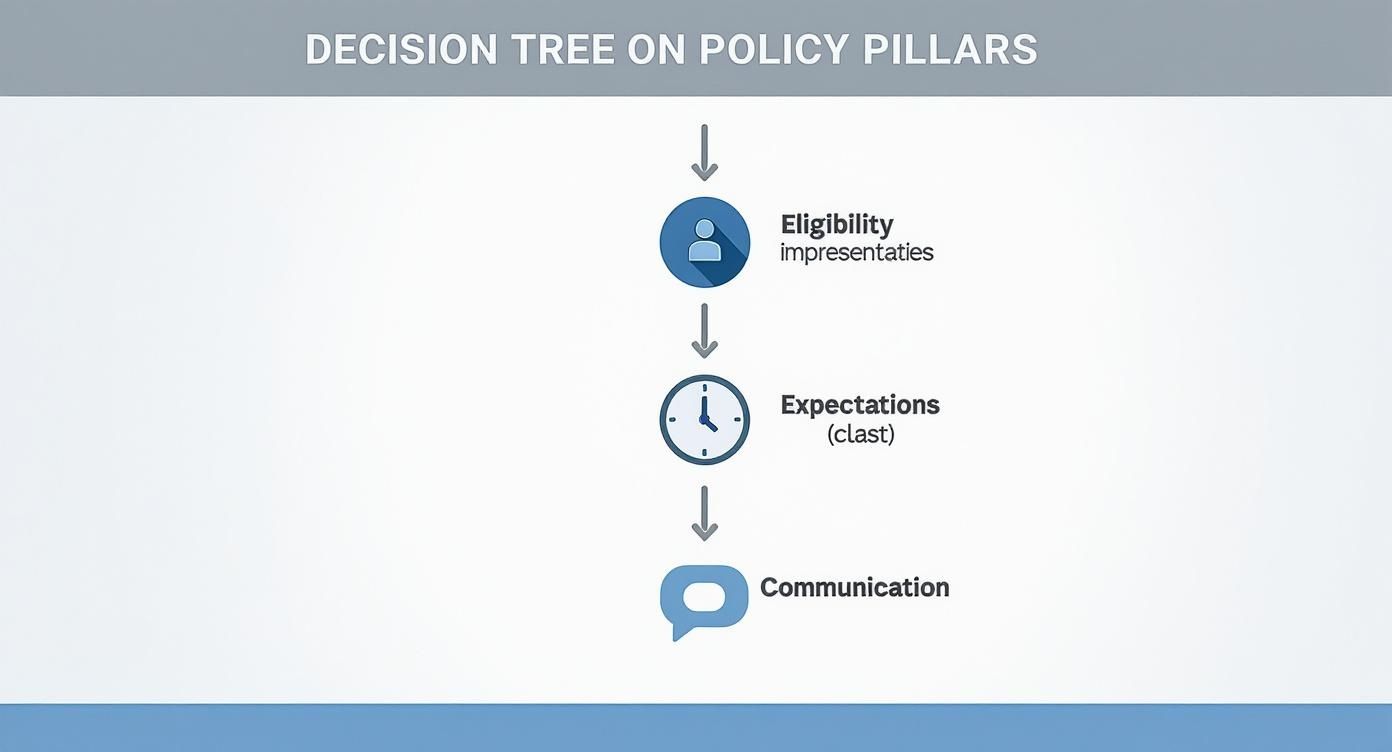Your Essential Remote Work Policy Template

A good remote work policy template is more than just an HR document—it's the bedrock of any successful distributed team. Think of it as your strategic guide for setting expectations, locking down security, and making sure the environment is fair for everyone, no matter where they log in from.
Why You Absolutely Need a Formal Policy

Trying to manage a remote team without a formal policy is like sailing without a compass. It might feel liberating at first, just handling things as they come up, but that ad-hoc approach quickly spirals into inconsistency, confusion, and even legal headaches. A well-thought-out policy isn't about red tape; it's a strategic asset that shifts your company from putting out fires to proactively building a strong foundation.
Without clear, written guidelines, you open the door to chaos. One manager might give their direct report a flexible hybrid schedule, while another denies a nearly identical request. This kind of inconsistency breeds resentment and kills morale faster than you can say "it's not fair."
Attracting Top Talent and Dodging Risks
In today's job market, flexibility isn't just a perk; it's a deal-breaker. The way we work has fundamentally changed. In 2023, around 28% of employees were working remotely, and the demand is only growing.
An eye-opening 91% of employees now say they prefer a work arrangement that is either fully or almost fully remote. This tells us that offering remote options is no longer a "nice-to-have"—it's a critical strategy for attracting the best people. You can find more details on these remote work trends and what they mean for businesses.
A formal policy also shows you’re serious about making remote work work, which makes your company instantly more attractive to top professionals. It also doubles as a crucial risk-management tool. For example, what happens if an employee's unsecured home Wi-Fi network leads to a massive data breach? A policy that clearly requires everyone to use a VPN and follow specific security protocols can be your best defense.
A remote work policy isn't about control; it's about clarity. It empowers employees by defining the boundaries of their autonomy and protects the organization by establishing a consistent, secure framework for everyone to follow.
Here’s a quick summary of the essential elements every remote work policy should include, providing a clear roadmap for the rest of the guide.
Key Policy Components at a Glance
| Policy Component | Core Focus Area | Why It Matters |
|---|---|---|
| Eligibility & Scope | Who can work remotely and how often | Sets clear, fair criteria for participation. |
| Work Hours & Availability | Core hours, time zones, and responsiveness | Ensures team collaboration and client service. |
| Equipment & Technology | Company-provided vs. personal gear, security | Protects company data and ensures productivity. |
| Communication Protocols | Tools, response times, meeting etiquette | Keeps everyone connected and on the same page. |
| Security & Confidentiality | Data protection, VPN usage, home network | Mitigates cybersecurity risks and prevents breaches. |
| Performance & Productivity | How success is measured and managed | Focuses on results, not just hours logged. |
Setting Clear Expectations for Everyone
Beyond attracting talent and managing risk, a policy sets the stage for genuine productivity. It preemptively answers all the tricky questions. How do we define "work hours" when the team is spread across multiple time zones? What's a reasonable response time on Slack? What are the valid reasons for work from home that the company officially supports?
When you put these standards in writing, you create a level playing field. Everyone knows the rules of the game, which frees them up to focus on doing great work instead of constantly trying to guess what’s expected of them. That kind of clarity is the key to building a remote or hybrid culture that’s stable, scalable, and truly equitable.
Getting into the Weeds: The Core of Your Remote Work Policy
Alright, we've covered the big picture. Now it's time to roll up our sleeves and get into the nuts and bolts of your policy. A truly effective remote work policy isn't about fluffy mission statements; it's built on clear, practical rules that tell everyone exactly how things are going to work. No ambiguity, no confusion.
This is where you spell out the day-to-day mechanics. Let's start with the most fundamental question: who gets to work remotely? It's a tough one, but being crystal clear from the start saves a world of headaches later on.
Who Is Eligible to Work Remotely?
First things first, you have to decide who qualifies. A one-size-fits-all approach rarely works because, let's be honest, not every job can be done from a home office.
Instead of a vague "most roles are eligible" statement, get specific. Think about the practical realities of different positions. Does the job require someone to be physically present to handle equipment? Has this person proven they can manage their own time and hit deadlines without a manager looking over their shoulder?
Here’s what I'd consider when drawing the line:
- Job Function: This is the most obvious one. Roles like software development or marketing are often a natural fit. But what about IT support that requires hands-on troubleshooting or R&D teams needing lab access? Be specific about any limitations.
- Performance History: It’s perfectly reasonable to make remote work a privilege earned through solid performance. You might require employees to be past their initial probationary period and have a consistent track record of good work.
- Location: Don't forget the legal and tax implications. You might need to limit remote work to certain states or countries to keep things manageable for your finance and HR teams.
For example, you could write something like this: "Full-time remote work is an option for employees in approved roles who have been with the company for at least six months and received a 'Meets Expectations' or higher on their last performance review." See? It's fair, clear, and directly tied to performance.
Setting Clear Expectations for Work Hours and Availability
This is a big one. One of the quickest ways for remote work to go off the rails is when nobody knows who is working when. Your policy needs to set a clear baseline for work hours and how quickly people are expected to respond. This isn't about micromanagement; it's about making sure the team can actually collaborate.
A huge mistake I see companies make is thinking "flexible hours" means "available 24/7." Real flexibility needs a bit of structure to work.
A great way to do this is by establishing core collaboration hours. This is a set block of time when everyone agrees to be online and available for meetings, brainstorming, and quick questions.
For a team spread between New York and California, your core hours might be 11 a.m. to 3 p.m. ET. This gives everyone a solid four-hour window for real-time work while still offering plenty of flexibility for focused tasks in the morning and afternoon. Nailing down these expectations is one of the most critical remote work best practices for keeping a team feeling connected and in sync.
Defining Your Communication Playbook
Think of this section as the user manual for how your team talks to each other. If you don't define it, you'll have one person sending urgent emails while another is waiting for a Slack message, leading to total chaos.
Get super explicit about your communication tools and when to use them:
- Urgent Stuff: First, define what an "emergency" is. Then, tell people exactly what to do—is it a phone call? A specific Slack channel with an
@herenotification? - Day-to-Day Chat: Name your go-to tool for quick questions and daily chatter, like Slack or Microsoft Teams. It's also helpful to set a general expectation for response times, like "within a couple of hours."
- Formal Updates & Big Picture: Where do project updates and official announcements live? Designate a place for less time-sensitive stuff, whether that's email or a project management tool like Asana.
How Will You Measure Success?
Finally, and maybe most importantly, your policy needs to make a fundamental shift: from tracking presence to measuring performance. When you can't see if someone is at their desk, the only thing that matters is the work they produce. That green "active" dot doesn't mean anything if deadlines are being missed.
Work with your managers to define clear, outcome-driven goals for every role.
For a content writer, success might be measured by the number of articles published and the traffic they generate. For a salesperson, it's the number of closed deals. This results-only focus builds a culture of trust and empowers people to work when and how they're most productive, because they know it's the outcome that counts.
Structuring Your Technology and Security Protocols
When your team works from anywhere, your tech and security policies essentially become the digital walls of your office. They're no longer just an IT checklist; they're the bedrock of your business's integrity, data protection, and even your team's productivity. A well-defined framework within your remote work policy template is what stands between you and a costly security breach, while also making sure everyone has the right tools to do their job well.
The first big question you need to tackle is about equipment. Are you providing the laptops, monitors, and other gear, or are employees using their own? This single decision has a massive ripple effect on both your security and your budget.
This decision tree gives you a bird's-eye view of the foundational pillars of a solid policy, starting with who is even eligible for remote work and moving all the way through setting expectations and communication rhythms.

As you can see, before you even get to the tech details, you absolutely must have clarity on the basics—the who, what, and how of your remote operations.
Company-Provided vs BYOD Policies
Deciding between company-provided equipment and a Bring Your Own Device (BYOD) model is a classic balancing act: control versus convenience.
With company-owned devices, your IT team is in the driver's seat. They have total control over security settings, software updates, and who can access what. This makes managing security much, much simpler.
On the other hand, a BYOD policy can save money and is often a hit with employees who love their own familiar tech. If you choose this path, you have to lay down some strict security rules. Think mandatory antivirus software and, crucially, the ability to remotely wipe company data if a device is lost or an employee moves on.
To help you sort through this, here’s a quick comparison of the two approaches.
Company-Provided vs BYOD Policy Comparison
| Consideration | Company-Provided Equipment | Bring Your Own Device (BYOD) |
|---|---|---|
| Initial Cost | High upfront investment in hardware. | Low to no upfront hardware cost. |
| Security Control | Maximum. IT has full control over software and security. | Limited. Relies on policies and user compliance. |
| IT Support | Simpler, as IT manages a standardized set of devices. | More complex, supporting a wide variety of personal devices. |
| Employee Experience | Can be less flexible; employees use assigned tech. | High, as employees use their preferred, familiar devices. |
| Onboarding/Offboarding | Straightforward process of issuing and retrieving devices. | Requires a clear process for wiping company data from personal tech. |
Ultimately, there's no single right answer. It comes down to your budget, your security needs, and your company culture.
I’ve seen a hybrid model work wonders. Offering a standardized tech stipend gives employees the freedom to pick their own gear while ensuring they have the budget for reliable equipment that meets your company’s security standards. It’s a great middle ground.
No matter which route you take, don't forget reimbursements. Your policy needs to be crystal clear about what the company covers, whether it's a piece of the monthly internet bill or a stipend for a phone plan. Being upfront prevents a lot of headaches down the road.
Establishing Non-Negotiable Security Rules
Your remote work policy is the perfect place to lay down some security ground rules that everyone must follow, no exceptions. The risk of a data breach skyrockets when people are working from countless locations on networks you don't control. For a much deeper dive, our guide on cybersecurity for remote workers has more advanced strategies.
At a minimum, here are a few essentials you need to bake into your policy:
- Secure Wi-Fi Usage: This is non-negotiable. Employees must connect only to password-protected, encrypted Wi-Fi networks. Using the public Wi-Fi at a coffee shop or airport for work is strictly off-limits unless they are using a VPN.
- Mandatory VPN Use: Require everyone to connect to the company’s Virtual Private Network (VPN) any time they access company systems or data. A VPN creates a secure, encrypted tunnel from their device back to your network, protecting data in transit.
- Data Handling and Storage: Be specific about where sensitive company data is allowed to live. Forbid using personal cloud storage (like a personal Google Drive or Dropbox) for work files and direct everyone to company-approved platforms.
- Regular Software Updates: Out-of-date software is a hacker's dream. Mandate that employees enable automatic updates for their operating systems and applications to ensure critical security patches are applied right away.
Designing a Policy for Hybrid Work Models
Finding that sweet spot between fully remote and fully in-office is where most companies are landing these days. But getting a hybrid model right takes more than just picking a few days for people to show up. A poorly planned policy can create a lot of friction and confusion, so the goal is to make time in the office feel intentional, not arbitrary.
There's a real tug-of-war happening in the modern workplace. Leaders are keen to get people back to their desks, but employees have come to value the flexibility remote work offers. The numbers tell the story: while 70% of companies now have some kind of return-to-office mandate, 41% of employees say they’d start job hunting if that mandate became full-time. These return to office statistics show a clear gap between what many companies want and what their people need.
Making In-Office Time Purposeful
The absolute key to a hybrid policy that people actually respect is defining the why. If your team is commuting an hour each way just to sit on Zoom calls at a different desk, you've missed the point entirely. The office needs to be for the things we genuinely do better face-to-face.
When you're building out your remote work policy template, frame the in-office days around high-impact, collaborative work.
- Team Brainstorming Sessions: This is perfect for kicking off a new project, mapping out a complex plan, or getting stuck into a tricky problem together.
- Cross-Departmental Collaboration: Use office days to get different teams talking. Those casual conversations in the kitchen can spark ideas that emails never will.
- Mentorship and Training: Nothing beats being in the same room for training. New hires and junior staff, in particular, soak up so much just by being around senior colleagues.
- Team Building and Culture: Don't underestimate the power of a team lunch or a simple coffee break. Schedule company-wide meetings or social events to build those personal connections that make work feel more human.
When you focus on these kinds of activities, the office stops being a place people have to be and becomes a destination for connection and innovation.
Structuring Hybrid Schedules
There’s no one-size-fits-all schedule here. The right model for you will depend entirely on how your teams work and what you’re trying to achieve. As you customize your template, think about which of these common approaches makes the most sense.
The best hybrid policies don’t just dictate a schedule. They create a framework that empowers teams to decide how to best use their time together, fostering a sense of ownership and making the office a destination with a purpose.
A "fixed hybrid" model is a popular choice. This is where everyone comes in on the same 2-3 days each week, like Tuesday through Thursday. It’s brilliant for predictability because you always know when you can get everyone in a room for a big meeting or team event.
On the other hand, a "flexible hybrid" model gives individuals or teams the power to choose their in-office days. This gives people maximum autonomy, but it requires a lot more coordination to make sure the right people are in the office at the right time. Whichever path you choose, your policy needs to be crystal clear about the approach and provide the tools to manage it without descending into chaos.
Adapting Your Template for Different Roles

Let's be honest: a single, rigid remote work policy for your entire company is bound to fail. The daily reality of a software engineer is completely different from that of a sales executive. Trying to shoehorn everyone into the same set of rules just creates friction where you need flexibility.
Think of your main remote work policy template as a foundation, not a finished house. From this core document, you can build specific addendums or sections for different departments. This approach keeps things fair and consistent while still accommodating the unique demands of each role.
Customizing for Technical and Creative Teams
When it comes to roles like software development, data science, or graphic design, it's all about deep, uninterrupted work. For these teams, your policy should champion asynchronous communication. That means relying on project management tools for updates instead of back-to-back meetings, giving them the space to actually focus.
Cybersecurity is also a much bigger deal for these folks. They're handling your most sensitive assets—proprietary code, customer data, and client IP. Your policy must get specific here.
- Strict VPN Usage: Make it mandatory for accessing any company network or repository. No exceptions.
- Secure Data Handling: Define exactly where code can be stored and how data should be transferred.
- Device Security: Insist on company-issued, encrypted laptops.
This isn't about micromanaging; it's about protecting your company while respecting their workflow.
Tailoring Policies for Client-Facing Roles
Now, flip the script for your client-facing teams in sales or consulting. Their world revolves around real-time interaction, so availability and a professional image are everything.
Your policy for a sales team isn't just about work hours; it's about defining the virtual "storefront." It needs to ensure a consistent and professional client experience, no matter where your team member is located.
Their version of the policy needs to cover scenarios like remote client meetings. Set clear expectations for professional backgrounds, appropriate attire, and reliable tech. You'll also want clear guidelines on travel and expense reimbursement for when they do need to meet clients in person.
Even as the job market tightens, the demand for certain remote roles remains strong. Recent reports show remote engineering job posts grew by 11%, while consulting and communications roles each saw a 5% increase. You can dig deeper into these industry-specific remote job trends to see where the talent is heading.
By creating role-specific guidelines, you create a policy that’s practical, equitable, and actually supports how each part of your business gets work done.
Sticking Points: Answering the Tough Questions About Remote Work Policies
Even the best remote work policy template can't cover every single real-world scenario. Once you start putting your policy into practice, you're bound to run into some tricky "what-if" situations. This is where the rubber meets the road.
Let's walk through some of the most common questions and sticking points that come up. Think of this as your practical, field-tested guide to handling the nuances of managing a distributed team.
How Can We Make Sure People Are Working Without Becoming Big Brother?
This is probably the number one fear I hear from managers shifting to remote leadership. The key is to completely reframe how you think about performance. Ditch the idea of "time in a chair" and focus entirely on outcomes, not activity. A green dot on Slack is just that—a dot. It tells you nothing about real progress.
Instead of playing digital watchdog, try this:
- Set Crystal-Clear Goals: Define what "done" looks like for every project. When the targets are specific and measurable, there's no ambiguity.
- Lean on Project Management Tools: A well-organized board in a tool like Asana or Trello gives everyone a clear view of progress. It makes work visible without you having to ask, "So, where are we with that?"
- Make Check-ins About Unblocking, Not Tracking: Shift your one-on-ones from "What did you do?" to "What roadblocks can I clear for you?" This single change turns you from a supervisor into a supportive resource.
Trust is your most powerful tool. When you give your team the autonomy to manage their time and deliver on their goals, they'll almost always rise to the occasion. Micromanagement, on the other hand, is the fastest way to burn out your best people, especially when they're remote.
What’s the Deal With Legal Risks When We Hire People in Different States?
Hiring across state lines—or even countries—is a legal minefield if you're not careful. It’s a huge mistake to assume that the labor laws where your HQ is located apply to everyone. The golden rule is simple: you have to follow the employment laws where the employee actually does the work.
This affects almost everything you can think of:
- Minimum wage laws and overtime calculations
- State and local payroll tax withholding
- Rules around paid sick leave or family leave
- Specific requirements for how you deliver a final paycheck
I can't stress this enough: you absolutely must talk to an employment lawyer who specializes in multi-state compliance. Getting this wrong can lead to staggering fines and messy lawsuits. You may even need to register as an employer in every state where you have a team member.
What Do We Do When Someone in a Typically "In-Office" Role Asks to Work Remotely?
When a request like this comes in, your first instinct might be a quick "no." Resist it. The better approach is to start a genuine, objective analysis of that person's core responsibilities. Can the most essential parts of their job actually be done well from home?
Document your evaluation process. This isn't just for show—it ensures you’re being fair and consistent across the board. If you ultimately have to deny the request, you can then point to specific, business-critical reasons tied directly to their job functions, not just a vague feeling.
This can also be a great moment to question your own assumptions. I've seen teams discover that a few new tools or a small tweak to a process can suddenly make a role far more remote-friendly than anyone imagined. A thoughtful review might just open up new possibilities for flexibility you hadn't even considered.
At RemoteWeek, we know that a great policy is the foundation for hiring great remote talent. If you're ready to find skilled professionals who will thrive in your new, well-structured remote environment, we can help. Discover your next great hire on our platform.
